Cryptography Algorithms, Security, and Network Protection Report
VerifiedAdded on 2022/12/30
|11
|2443
|35
Report
AI Summary
This report delves into the critical role of cryptography in ensuring information security within software and networks. It identifies and describes three main types of cryptographic algorithms: symmetric, asymmetric, and hashing algorithms. Symmetric algorithms, like AES, DES, and 3DES, are discussed in the context of shared-key encryption, highlighting their use in IPsec and VPNs. Asymmetric algorithms, such as RSA, are examined for their public-key cryptography approach and computational burdens. Hashing algorithms, including MD5 and SHA-1, are presented for their role in data integrity. The report then explores the application of these algorithms in specific technology solutions, including cloud computing security with AES, security in the National Security Agency with DES, and network security with RSA. The report also addresses the critical role of physical security, specifically focusing on the risks associated with mobile devices (BYOD) and unpatched or unpatchable devices, providing insights into BYOD policies and security measures. References to relevant literature support the analysis.

Running head: CRYPTOGRAPHY ALGORITHM
CRYPTOGRAPHY ALGORITHM
Name of the Student
Name of the University
Author Note
CRYPTOGRAPHY ALGORITHM
Name of the Student
Name of the University
Author Note
Paraphrase This Document
Need a fresh take? Get an instant paraphrase of this document with our AI Paraphraser
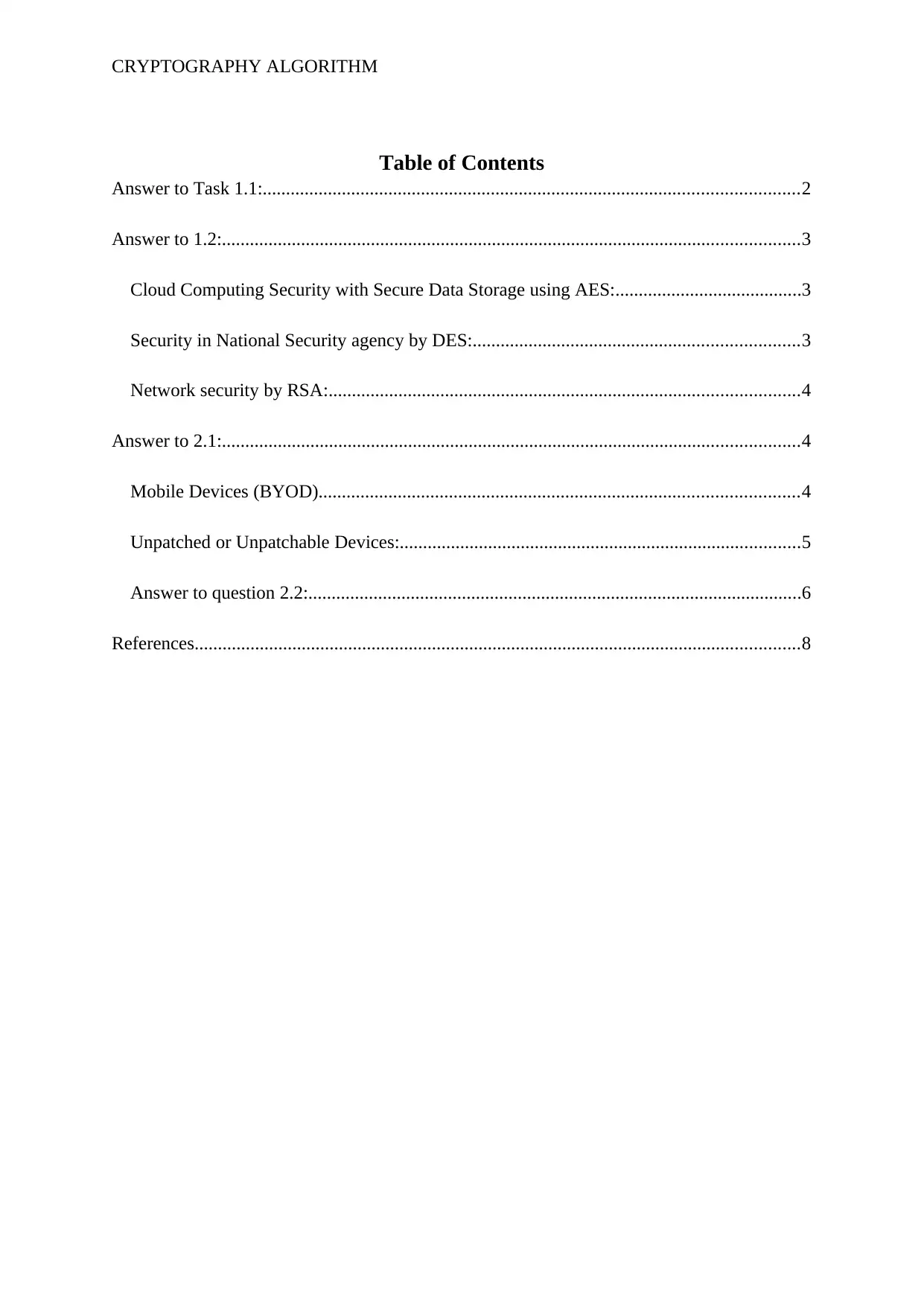
CRYPTOGRAPHY ALGORITHM
Table of Contents
Answer to Task 1.1:...................................................................................................................2
Answer to 1.2:............................................................................................................................3
Cloud Computing Security with Secure Data Storage using AES:........................................3
Security in National Security agency by DES:......................................................................3
Network security by RSA:.....................................................................................................4
Answer to 2.1:............................................................................................................................4
Mobile Devices (BYOD).......................................................................................................4
Unpatched or Unpatchable Devices:......................................................................................5
Answer to question 2.2:..........................................................................................................6
References..................................................................................................................................8
Table of Contents
Answer to Task 1.1:...................................................................................................................2
Answer to 1.2:............................................................................................................................3
Cloud Computing Security with Secure Data Storage using AES:........................................3
Security in National Security agency by DES:......................................................................3
Network security by RSA:.....................................................................................................4
Answer to 2.1:............................................................................................................................4
Mobile Devices (BYOD).......................................................................................................4
Unpatched or Unpatchable Devices:......................................................................................5
Answer to question 2.2:..........................................................................................................6
References..................................................................................................................................8
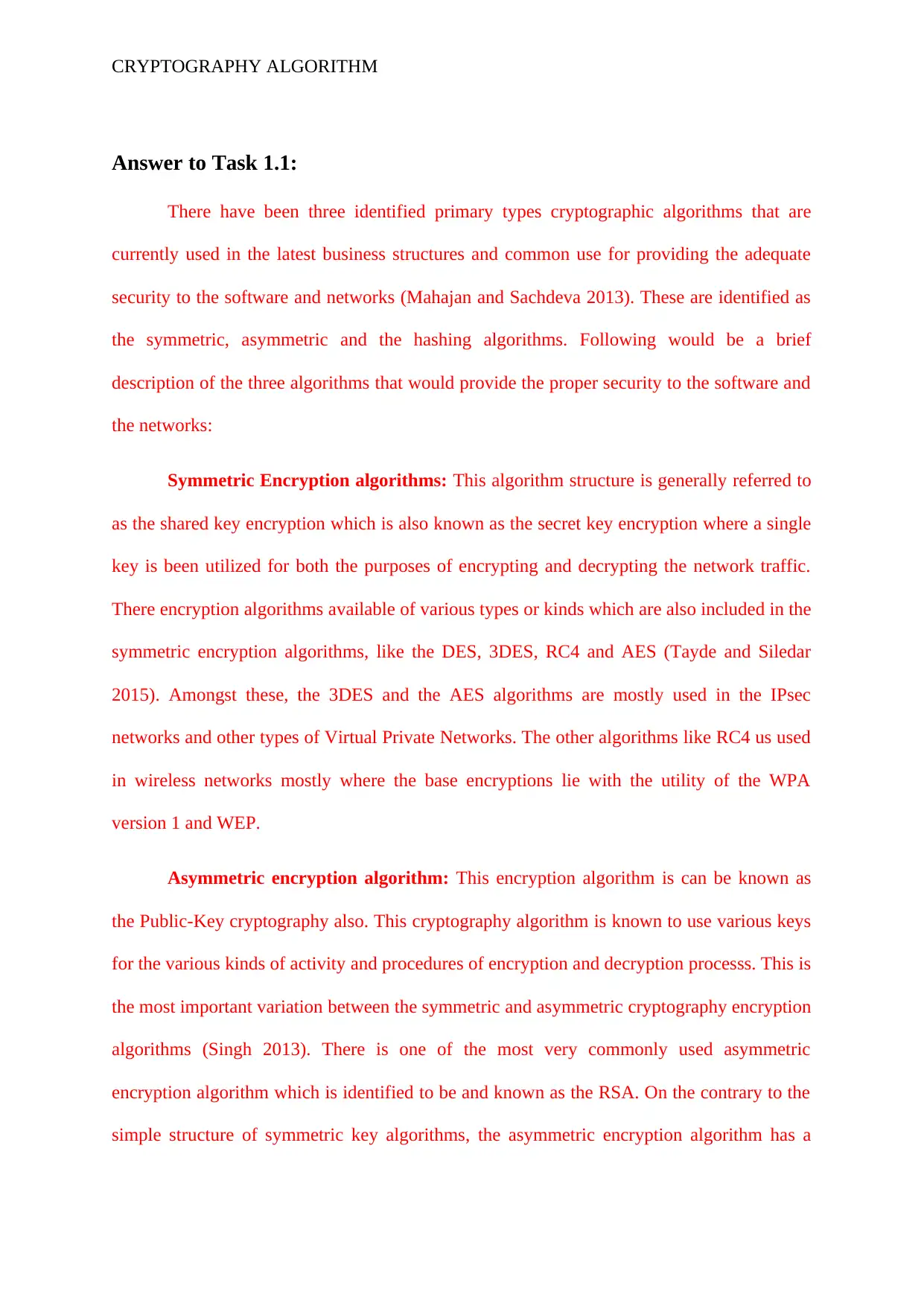
CRYPTOGRAPHY ALGORITHM
Answer to Task 1.1:
There have been three identified primary types cryptographic algorithms that are
currently used in the latest business structures and common use for providing the adequate
security to the software and networks (Mahajan and Sachdeva 2013). These are identified as
the symmetric, asymmetric and the hashing algorithms. Following would be a brief
description of the three algorithms that would provide the proper security to the software and
the networks:
Symmetric Encryption algorithms: This algorithm structure is generally referred to
as the shared key encryption which is also known as the secret key encryption where a single
key is been utilized for both the purposes of encrypting and decrypting the network traffic.
There encryption algorithms available of various types or kinds which are also included in the
symmetric encryption algorithms, like the DES, 3DES, RC4 and AES (Tayde and Siledar
2015). Amongst these, the 3DES and the AES algorithms are mostly used in the IPsec
networks and other types of Virtual Private Networks. The other algorithms like RC4 us used
in wireless networks mostly where the base encryptions lie with the utility of the WPA
version 1 and WEP.
Asymmetric encryption algorithm: This encryption algorithm is can be known as
the Public-Key cryptography also. This cryptography algorithm is known to use various keys
for the various kinds of activity and procedures of encryption and decryption processs. This is
the most important variation between the symmetric and asymmetric cryptography encryption
algorithms (Singh 2013). There is one of the most very commonly used asymmetric
encryption algorithm which is identified to be and known as the RSA. On the contrary to the
simple structure of symmetric key algorithms, the asymmetric encryption algorithm has a
Answer to Task 1.1:
There have been three identified primary types cryptographic algorithms that are
currently used in the latest business structures and common use for providing the adequate
security to the software and networks (Mahajan and Sachdeva 2013). These are identified as
the symmetric, asymmetric and the hashing algorithms. Following would be a brief
description of the three algorithms that would provide the proper security to the software and
the networks:
Symmetric Encryption algorithms: This algorithm structure is generally referred to
as the shared key encryption which is also known as the secret key encryption where a single
key is been utilized for both the purposes of encrypting and decrypting the network traffic.
There encryption algorithms available of various types or kinds which are also included in the
symmetric encryption algorithms, like the DES, 3DES, RC4 and AES (Tayde and Siledar
2015). Amongst these, the 3DES and the AES algorithms are mostly used in the IPsec
networks and other types of Virtual Private Networks. The other algorithms like RC4 us used
in wireless networks mostly where the base encryptions lie with the utility of the WPA
version 1 and WEP.
Asymmetric encryption algorithm: This encryption algorithm is can be known as
the Public-Key cryptography also. This cryptography algorithm is known to use various keys
for the various kinds of activity and procedures of encryption and decryption processs. This is
the most important variation between the symmetric and asymmetric cryptography encryption
algorithms (Singh 2013). There is one of the most very commonly used asymmetric
encryption algorithm which is identified to be and known as the RSA. On the contrary to the
simple structure of symmetric key algorithms, the asymmetric encryption algorithm has a
⊘ This is a preview!⊘
Do you want full access?
Subscribe today to unlock all pages.

Trusted by 1+ million students worldwide
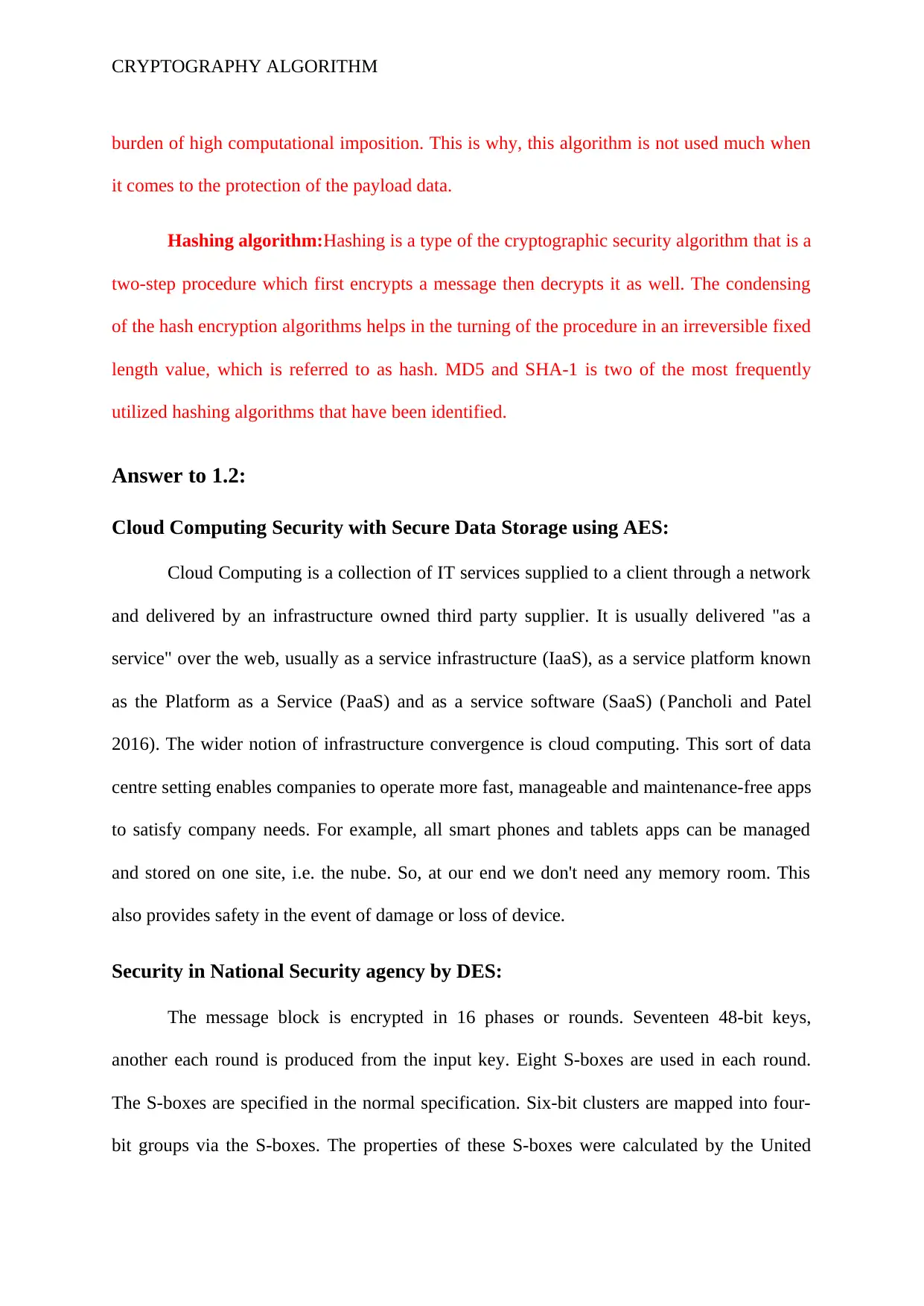
CRYPTOGRAPHY ALGORITHM
burden of high computational imposition. This is why, this algorithm is not used much when
it comes to the protection of the payload data.
Hashing algorithm:Hashing is a type of the cryptographic security algorithm that is a
two-step procedure which first encrypts a message then decrypts it as well. The condensing
of the hash encryption algorithms helps in the turning of the procedure in an irreversible fixed
length value, which is referred to as hash. MD5 and SHA-1 is two of the most frequently
utilized hashing algorithms that have been identified.
Answer to 1.2:
Cloud Computing Security with Secure Data Storage using AES:
Cloud Computing is a collection of IT services supplied to a client through a network
and delivered by an infrastructure owned third party supplier. It is usually delivered "as a
service" over the web, usually as a service infrastructure (IaaS), as a service platform known
as the Platform as a Service (PaaS) and as a service software (SaaS) (Pancholi and Patel
2016). The wider notion of infrastructure convergence is cloud computing. This sort of data
centre setting enables companies to operate more fast, manageable and maintenance-free apps
to satisfy company needs. For example, all smart phones and tablets apps can be managed
and stored on one site, i.e. the nube. So, at our end we don't need any memory room. This
also provides safety in the event of damage or loss of device.
Security in National Security agency by DES:
The message block is encrypted in 16 phases or rounds. Seventeen 48-bit keys,
another each round is produced from the input key. Eight S-boxes are used in each round.
The S-boxes are specified in the normal specification. Six-bit clusters are mapped into four-
bit groups via the S-boxes. The properties of these S-boxes were calculated by the United
burden of high computational imposition. This is why, this algorithm is not used much when
it comes to the protection of the payload data.
Hashing algorithm:Hashing is a type of the cryptographic security algorithm that is a
two-step procedure which first encrypts a message then decrypts it as well. The condensing
of the hash encryption algorithms helps in the turning of the procedure in an irreversible fixed
length value, which is referred to as hash. MD5 and SHA-1 is two of the most frequently
utilized hashing algorithms that have been identified.
Answer to 1.2:
Cloud Computing Security with Secure Data Storage using AES:
Cloud Computing is a collection of IT services supplied to a client through a network
and delivered by an infrastructure owned third party supplier. It is usually delivered "as a
service" over the web, usually as a service infrastructure (IaaS), as a service platform known
as the Platform as a Service (PaaS) and as a service software (SaaS) (Pancholi and Patel
2016). The wider notion of infrastructure convergence is cloud computing. This sort of data
centre setting enables companies to operate more fast, manageable and maintenance-free apps
to satisfy company needs. For example, all smart phones and tablets apps can be managed
and stored on one site, i.e. the nube. So, at our end we don't need any memory room. This
also provides safety in the event of damage or loss of device.
Security in National Security agency by DES:
The message block is encrypted in 16 phases or rounds. Seventeen 48-bit keys,
another each round is produced from the input key. Eight S-boxes are used in each round.
The S-boxes are specified in the normal specification. Six-bit clusters are mapped into four-
bit groups via the S-boxes. The properties of these S-boxes were calculated by the United
Paraphrase This Document
Need a fresh take? Get an instant paraphrase of this document with our AI Paraphraser
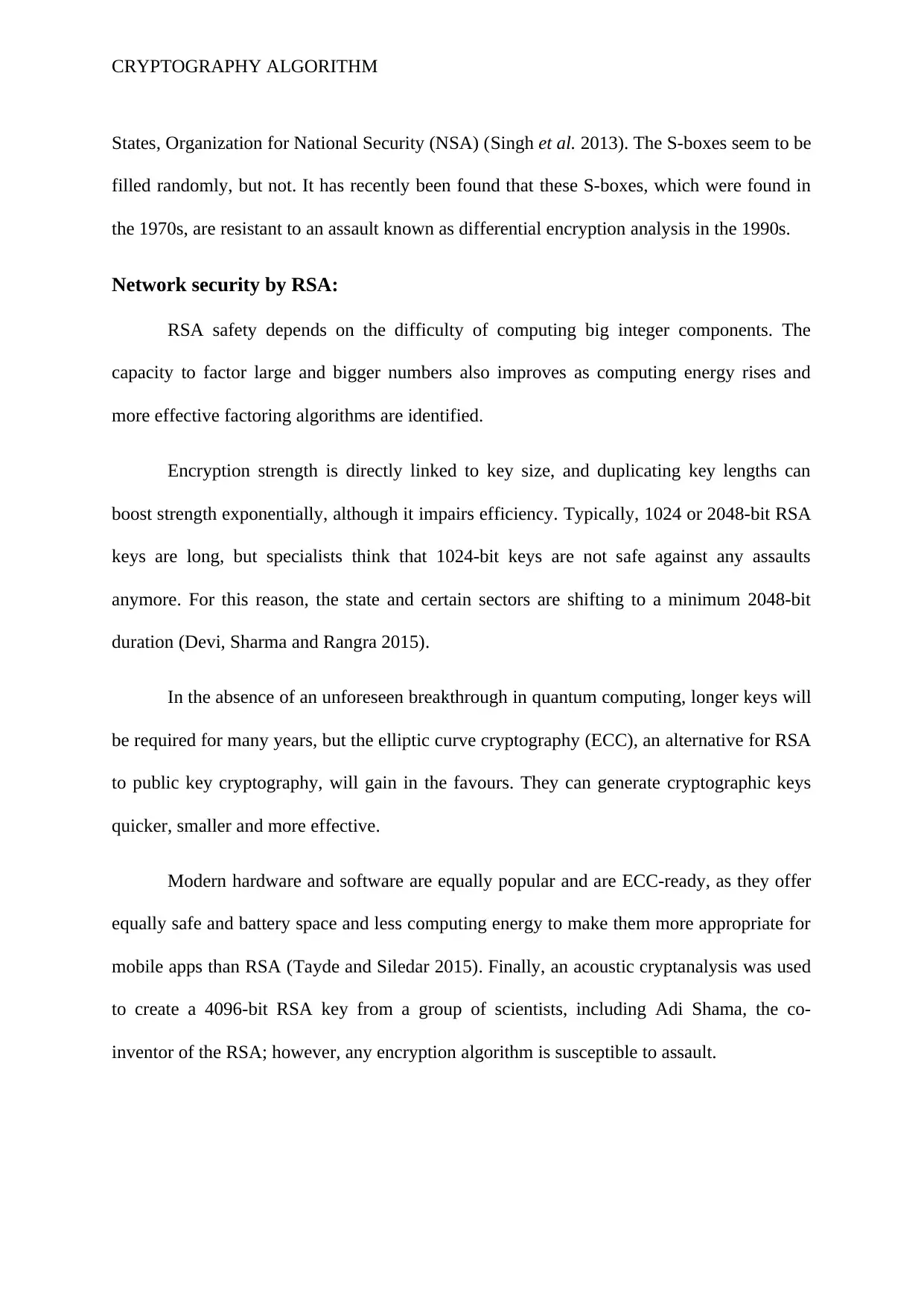
CRYPTOGRAPHY ALGORITHM
States, Organization for National Security (NSA) (Singh et al. 2013). The S-boxes seem to be
filled randomly, but not. It has recently been found that these S-boxes, which were found in
the 1970s, are resistant to an assault known as differential encryption analysis in the 1990s.
Network security by RSA:
RSA safety depends on the difficulty of computing big integer components. The
capacity to factor large and bigger numbers also improves as computing energy rises and
more effective factoring algorithms are identified.
Encryption strength is directly linked to key size, and duplicating key lengths can
boost strength exponentially, although it impairs efficiency. Typically, 1024 or 2048-bit RSA
keys are long, but specialists think that 1024-bit keys are not safe against any assaults
anymore. For this reason, the state and certain sectors are shifting to a minimum 2048-bit
duration (Devi, Sharma and Rangra 2015).
In the absence of an unforeseen breakthrough in quantum computing, longer keys will
be required for many years, but the elliptic curve cryptography (ECC), an alternative for RSA
to public key cryptography, will gain in the favours. They can generate cryptographic keys
quicker, smaller and more effective.
Modern hardware and software are equally popular and are ECC-ready, as they offer
equally safe and battery space and less computing energy to make them more appropriate for
mobile apps than RSA (Tayde and Siledar 2015). Finally, an acoustic cryptanalysis was used
to create a 4096-bit RSA key from a group of scientists, including Adi Shama, the co-
inventor of the RSA; however, any encryption algorithm is susceptible to assault.
States, Organization for National Security (NSA) (Singh et al. 2013). The S-boxes seem to be
filled randomly, but not. It has recently been found that these S-boxes, which were found in
the 1970s, are resistant to an assault known as differential encryption analysis in the 1990s.
Network security by RSA:
RSA safety depends on the difficulty of computing big integer components. The
capacity to factor large and bigger numbers also improves as computing energy rises and
more effective factoring algorithms are identified.
Encryption strength is directly linked to key size, and duplicating key lengths can
boost strength exponentially, although it impairs efficiency. Typically, 1024 or 2048-bit RSA
keys are long, but specialists think that 1024-bit keys are not safe against any assaults
anymore. For this reason, the state and certain sectors are shifting to a minimum 2048-bit
duration (Devi, Sharma and Rangra 2015).
In the absence of an unforeseen breakthrough in quantum computing, longer keys will
be required for many years, but the elliptic curve cryptography (ECC), an alternative for RSA
to public key cryptography, will gain in the favours. They can generate cryptographic keys
quicker, smaller and more effective.
Modern hardware and software are equally popular and are ECC-ready, as they offer
equally safe and battery space and less computing energy to make them more appropriate for
mobile apps than RSA (Tayde and Siledar 2015). Finally, an acoustic cryptanalysis was used
to create a 4096-bit RSA key from a group of scientists, including Adi Shama, the co-
inventor of the RSA; however, any encryption algorithm is susceptible to assault.
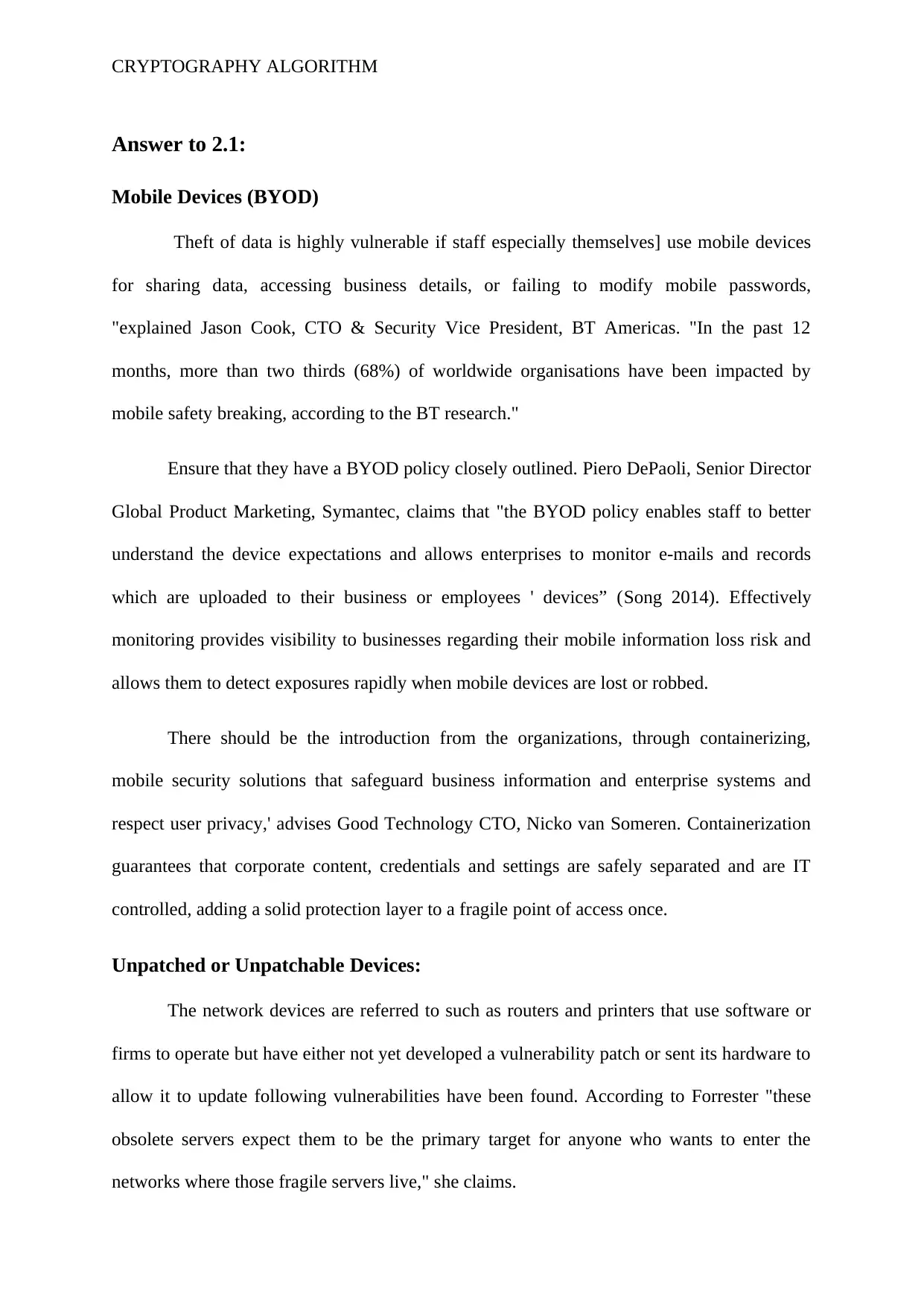
CRYPTOGRAPHY ALGORITHM
Answer to 2.1:
Mobile Devices (BYOD)
Theft of data is highly vulnerable if staff especially themselves] use mobile devices
for sharing data, accessing business details, or failing to modify mobile passwords,
"explained Jason Cook, CTO & Security Vice President, BT Americas. "In the past 12
months, more than two thirds (68%) of worldwide organisations have been impacted by
mobile safety breaking, according to the BT research."
Ensure that they have a BYOD policy closely outlined. Piero DePaoli, Senior Director
Global Product Marketing, Symantec, claims that "the BYOD policy enables staff to better
understand the device expectations and allows enterprises to monitor e-mails and records
which are uploaded to their business or employees ' devices” (Song 2014). Effectively
monitoring provides visibility to businesses regarding their mobile information loss risk and
allows them to detect exposures rapidly when mobile devices are lost or robbed.
There should be the introduction from the organizations, through containerizing,
mobile security solutions that safeguard business information and enterprise systems and
respect user privacy,' advises Good Technology CTO, Nicko van Someren. Containerization
guarantees that corporate content, credentials and settings are safely separated and are IT
controlled, adding a solid protection layer to a fragile point of access once.
Unpatched or Unpatchable Devices:
The network devices are referred to such as routers and printers that use software or
firms to operate but have either not yet developed a vulnerability patch or sent its hardware to
allow it to update following vulnerabilities have been found. According to Forrester "these
obsolete servers expect them to be the primary target for anyone who wants to enter the
networks where those fragile servers live," she claims.
Answer to 2.1:
Mobile Devices (BYOD)
Theft of data is highly vulnerable if staff especially themselves] use mobile devices
for sharing data, accessing business details, or failing to modify mobile passwords,
"explained Jason Cook, CTO & Security Vice President, BT Americas. "In the past 12
months, more than two thirds (68%) of worldwide organisations have been impacted by
mobile safety breaking, according to the BT research."
Ensure that they have a BYOD policy closely outlined. Piero DePaoli, Senior Director
Global Product Marketing, Symantec, claims that "the BYOD policy enables staff to better
understand the device expectations and allows enterprises to monitor e-mails and records
which are uploaded to their business or employees ' devices” (Song 2014). Effectively
monitoring provides visibility to businesses regarding their mobile information loss risk and
allows them to detect exposures rapidly when mobile devices are lost or robbed.
There should be the introduction from the organizations, through containerizing,
mobile security solutions that safeguard business information and enterprise systems and
respect user privacy,' advises Good Technology CTO, Nicko van Someren. Containerization
guarantees that corporate content, credentials and settings are safely separated and are IT
controlled, adding a solid protection layer to a fragile point of access once.
Unpatched or Unpatchable Devices:
The network devices are referred to such as routers and printers that use software or
firms to operate but have either not yet developed a vulnerability patch or sent its hardware to
allow it to update following vulnerabilities have been found. According to Forrester "these
obsolete servers expect them to be the primary target for anyone who wants to enter the
networks where those fragile servers live," she claims.
⊘ This is a preview!⊘
Do you want full access?
Subscribe today to unlock all pages.

Trusted by 1+ million students worldwide
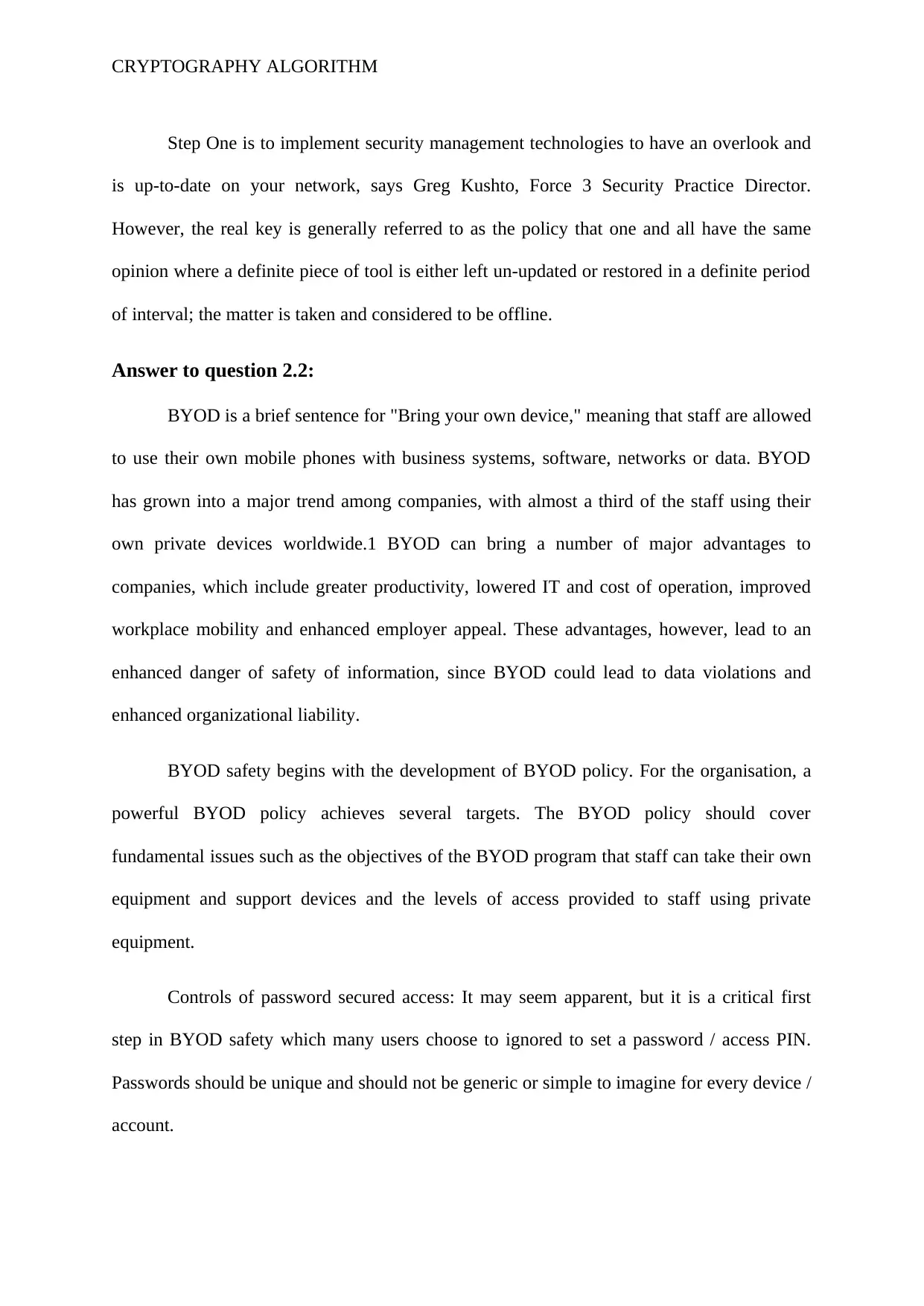
CRYPTOGRAPHY ALGORITHM
Step One is to implement security management technologies to have an overlook and
is up-to-date on your network, says Greg Kushto, Force 3 Security Practice Director.
However, the real key is generally referred to as the policy that one and all have the same
opinion where a definite piece of tool is either left un-updated or restored in a definite period
of interval; the matter is taken and considered to be offline.
Answer to question 2.2:
BYOD is a brief sentence for "Bring your own device," meaning that staff are allowed
to use their own mobile phones with business systems, software, networks or data. BYOD
has grown into a major trend among companies, with almost a third of the staff using their
own private devices worldwide.1 BYOD can bring a number of major advantages to
companies, which include greater productivity, lowered IT and cost of operation, improved
workplace mobility and enhanced employer appeal. These advantages, however, lead to an
enhanced danger of safety of information, since BYOD could lead to data violations and
enhanced organizational liability.
BYOD safety begins with the development of BYOD policy. For the organisation, a
powerful BYOD policy achieves several targets. The BYOD policy should cover
fundamental issues such as the objectives of the BYOD program that staff can take their own
equipment and support devices and the levels of access provided to staff using private
equipment.
Controls of password secured access: It may seem apparent, but it is a critical first
step in BYOD safety which many users choose to ignored to set a password / access PIN.
Passwords should be unique and should not be generic or simple to imagine for every device /
account.
Step One is to implement security management technologies to have an overlook and
is up-to-date on your network, says Greg Kushto, Force 3 Security Practice Director.
However, the real key is generally referred to as the policy that one and all have the same
opinion where a definite piece of tool is either left un-updated or restored in a definite period
of interval; the matter is taken and considered to be offline.
Answer to question 2.2:
BYOD is a brief sentence for "Bring your own device," meaning that staff are allowed
to use their own mobile phones with business systems, software, networks or data. BYOD
has grown into a major trend among companies, with almost a third of the staff using their
own private devices worldwide.1 BYOD can bring a number of major advantages to
companies, which include greater productivity, lowered IT and cost of operation, improved
workplace mobility and enhanced employer appeal. These advantages, however, lead to an
enhanced danger of safety of information, since BYOD could lead to data violations and
enhanced organizational liability.
BYOD safety begins with the development of BYOD policy. For the organisation, a
powerful BYOD policy achieves several targets. The BYOD policy should cover
fundamental issues such as the objectives of the BYOD program that staff can take their own
equipment and support devices and the levels of access provided to staff using private
equipment.
Controls of password secured access: It may seem apparent, but it is a critical first
step in BYOD safety which many users choose to ignored to set a password / access PIN.
Passwords should be unique and should not be generic or simple to imagine for every device /
account.
Paraphrase This Document
Need a fresh take? Get an instant paraphrase of this document with our AI Paraphraser
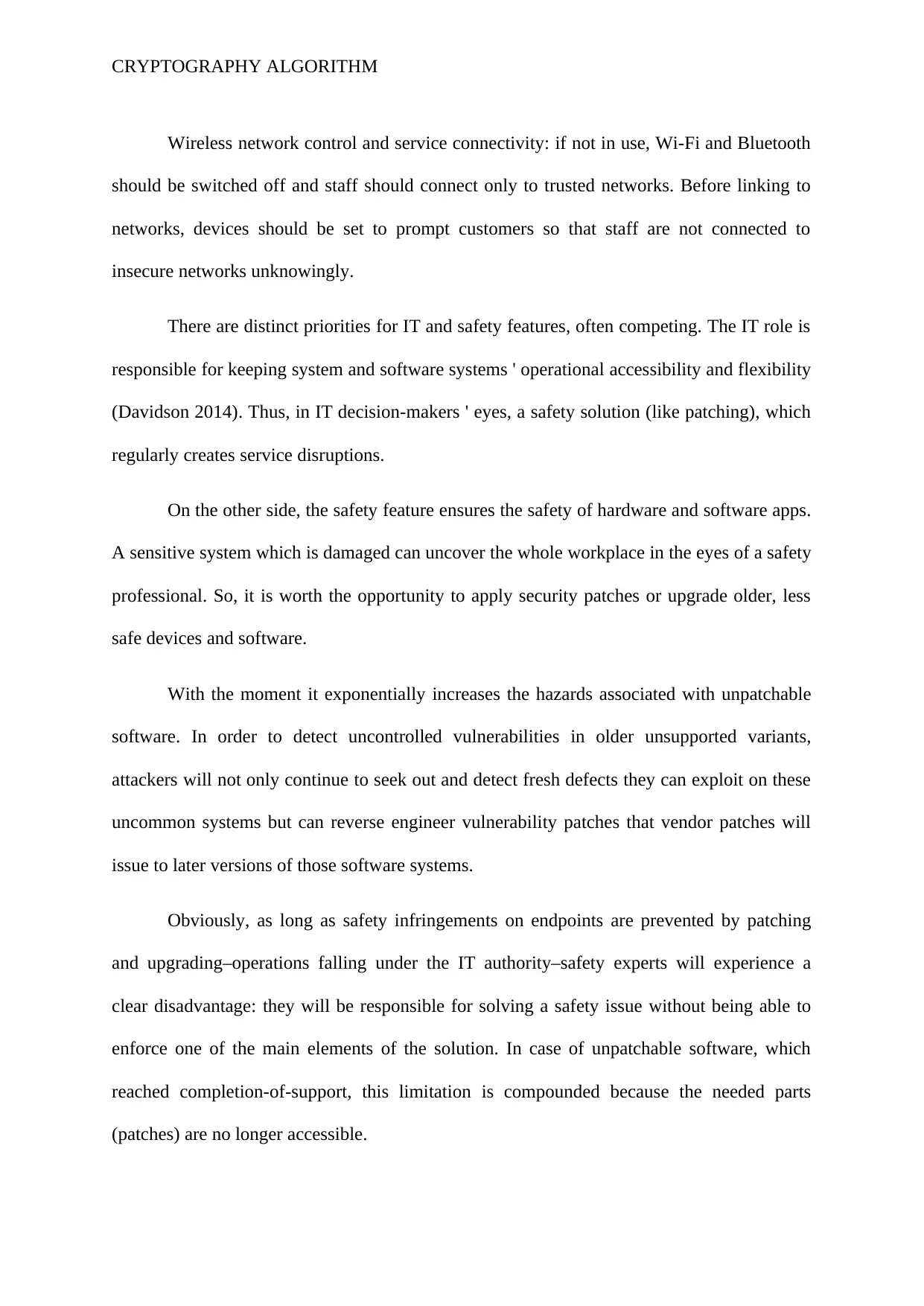
CRYPTOGRAPHY ALGORITHM
Wireless network control and service connectivity: if not in use, Wi-Fi and Bluetooth
should be switched off and staff should connect only to trusted networks. Before linking to
networks, devices should be set to prompt customers so that staff are not connected to
insecure networks unknowingly.
There are distinct priorities for IT and safety features, often competing. The IT role is
responsible for keeping system and software systems ' operational accessibility and flexibility
(Davidson 2014). Thus, in IT decision-makers ' eyes, a safety solution (like patching), which
regularly creates service disruptions.
On the other side, the safety feature ensures the safety of hardware and software apps.
A sensitive system which is damaged can uncover the whole workplace in the eyes of a safety
professional. So, it is worth the opportunity to apply security patches or upgrade older, less
safe devices and software.
With the moment it exponentially increases the hazards associated with unpatchable
software. In order to detect uncontrolled vulnerabilities in older unsupported variants,
attackers will not only continue to seek out and detect fresh defects they can exploit on these
uncommon systems but can reverse engineer vulnerability patches that vendor patches will
issue to later versions of those software systems.
Obviously, as long as safety infringements on endpoints are prevented by patching
and upgrading–operations falling under the IT authority–safety experts will experience a
clear disadvantage: they will be responsible for solving a safety issue without being able to
enforce one of the main elements of the solution. In case of unpatchable software, which
reached completion-of-support, this limitation is compounded because the needed parts
(patches) are no longer accessible.
Wireless network control and service connectivity: if not in use, Wi-Fi and Bluetooth
should be switched off and staff should connect only to trusted networks. Before linking to
networks, devices should be set to prompt customers so that staff are not connected to
insecure networks unknowingly.
There are distinct priorities for IT and safety features, often competing. The IT role is
responsible for keeping system and software systems ' operational accessibility and flexibility
(Davidson 2014). Thus, in IT decision-makers ' eyes, a safety solution (like patching), which
regularly creates service disruptions.
On the other side, the safety feature ensures the safety of hardware and software apps.
A sensitive system which is damaged can uncover the whole workplace in the eyes of a safety
professional. So, it is worth the opportunity to apply security patches or upgrade older, less
safe devices and software.
With the moment it exponentially increases the hazards associated with unpatchable
software. In order to detect uncontrolled vulnerabilities in older unsupported variants,
attackers will not only continue to seek out and detect fresh defects they can exploit on these
uncommon systems but can reverse engineer vulnerability patches that vendor patches will
issue to later versions of those software systems.
Obviously, as long as safety infringements on endpoints are prevented by patching
and upgrading–operations falling under the IT authority–safety experts will experience a
clear disadvantage: they will be responsible for solving a safety issue without being able to
enforce one of the main elements of the solution. In case of unpatchable software, which
reached completion-of-support, this limitation is compounded because the needed parts
(patches) are no longer accessible.

CRYPTOGRAPHY ALGORITHM
⊘ This is a preview!⊘
Do you want full access?
Subscribe today to unlock all pages.

Trusted by 1+ million students worldwide
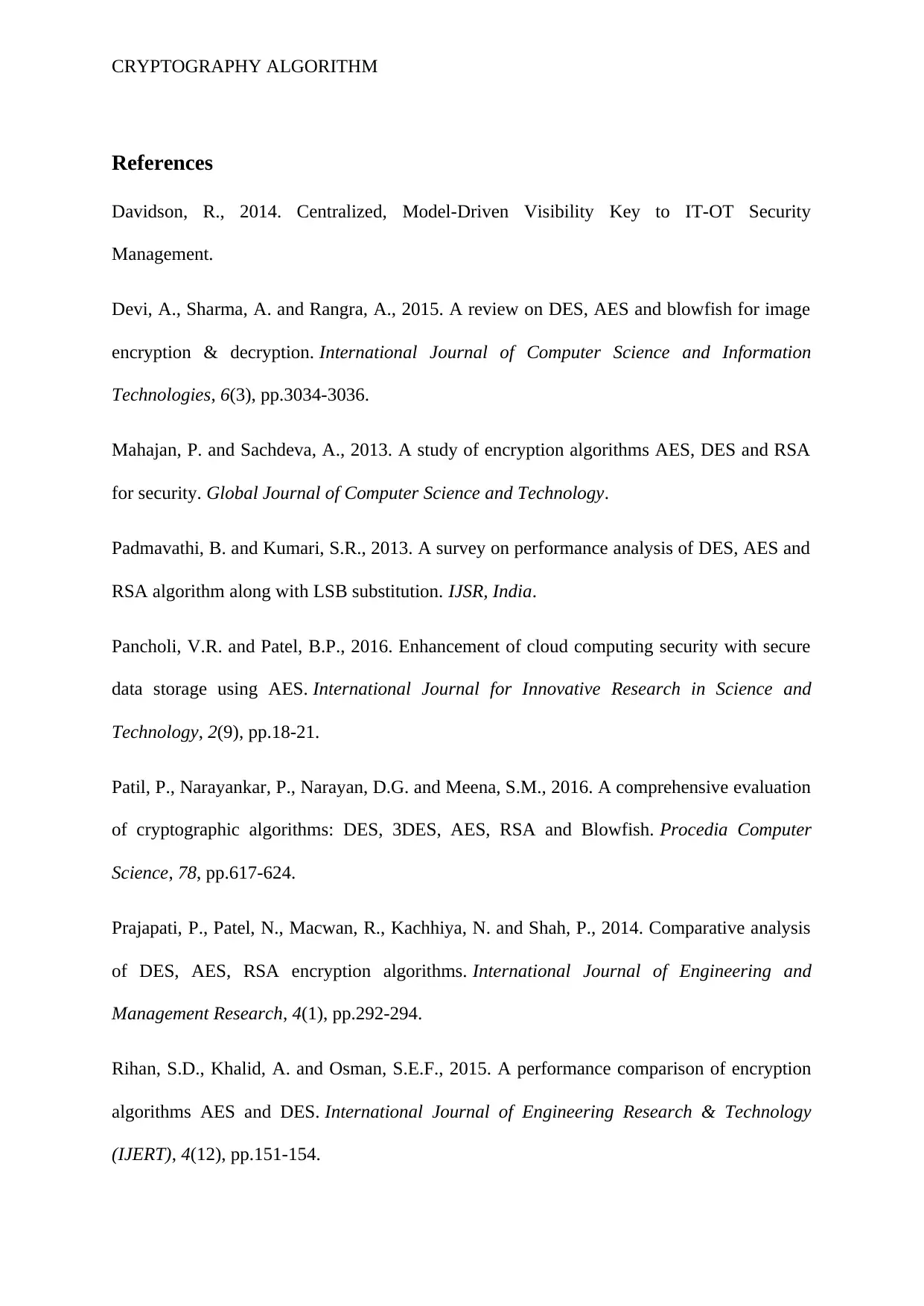
CRYPTOGRAPHY ALGORITHM
References
Davidson, R., 2014. Centralized, Model-Driven Visibility Key to IT-OT Security
Management.
Devi, A., Sharma, A. and Rangra, A., 2015. A review on DES, AES and blowfish for image
encryption & decryption. International Journal of Computer Science and Information
Technologies, 6(3), pp.3034-3036.
Mahajan, P. and Sachdeva, A., 2013. A study of encryption algorithms AES, DES and RSA
for security. Global Journal of Computer Science and Technology.
Padmavathi, B. and Kumari, S.R., 2013. A survey on performance analysis of DES, AES and
RSA algorithm along with LSB substitution. IJSR, India.
Pancholi, V.R. and Patel, B.P., 2016. Enhancement of cloud computing security with secure
data storage using AES. International Journal for Innovative Research in Science and
Technology, 2(9), pp.18-21.
Patil, P., Narayankar, P., Narayan, D.G. and Meena, S.M., 2016. A comprehensive evaluation
of cryptographic algorithms: DES, 3DES, AES, RSA and Blowfish. Procedia Computer
Science, 78, pp.617-624.
Prajapati, P., Patel, N., Macwan, R., Kachhiya, N. and Shah, P., 2014. Comparative analysis
of DES, AES, RSA encryption algorithms. International Journal of Engineering and
Management Research, 4(1), pp.292-294.
Rihan, S.D., Khalid, A. and Osman, S.E.F., 2015. A performance comparison of encryption
algorithms AES and DES. International Journal of Engineering Research & Technology
(IJERT), 4(12), pp.151-154.
References
Davidson, R., 2014. Centralized, Model-Driven Visibility Key to IT-OT Security
Management.
Devi, A., Sharma, A. and Rangra, A., 2015. A review on DES, AES and blowfish for image
encryption & decryption. International Journal of Computer Science and Information
Technologies, 6(3), pp.3034-3036.
Mahajan, P. and Sachdeva, A., 2013. A study of encryption algorithms AES, DES and RSA
for security. Global Journal of Computer Science and Technology.
Padmavathi, B. and Kumari, S.R., 2013. A survey on performance analysis of DES, AES and
RSA algorithm along with LSB substitution. IJSR, India.
Pancholi, V.R. and Patel, B.P., 2016. Enhancement of cloud computing security with secure
data storage using AES. International Journal for Innovative Research in Science and
Technology, 2(9), pp.18-21.
Patil, P., Narayankar, P., Narayan, D.G. and Meena, S.M., 2016. A comprehensive evaluation
of cryptographic algorithms: DES, 3DES, AES, RSA and Blowfish. Procedia Computer
Science, 78, pp.617-624.
Prajapati, P., Patel, N., Macwan, R., Kachhiya, N. and Shah, P., 2014. Comparative analysis
of DES, AES, RSA encryption algorithms. International Journal of Engineering and
Management Research, 4(1), pp.292-294.
Rihan, S.D., Khalid, A. and Osman, S.E.F., 2015. A performance comparison of encryption
algorithms AES and DES. International Journal of Engineering Research & Technology
(IJERT), 4(12), pp.151-154.
Paraphrase This Document
Need a fresh take? Get an instant paraphrase of this document with our AI Paraphraser
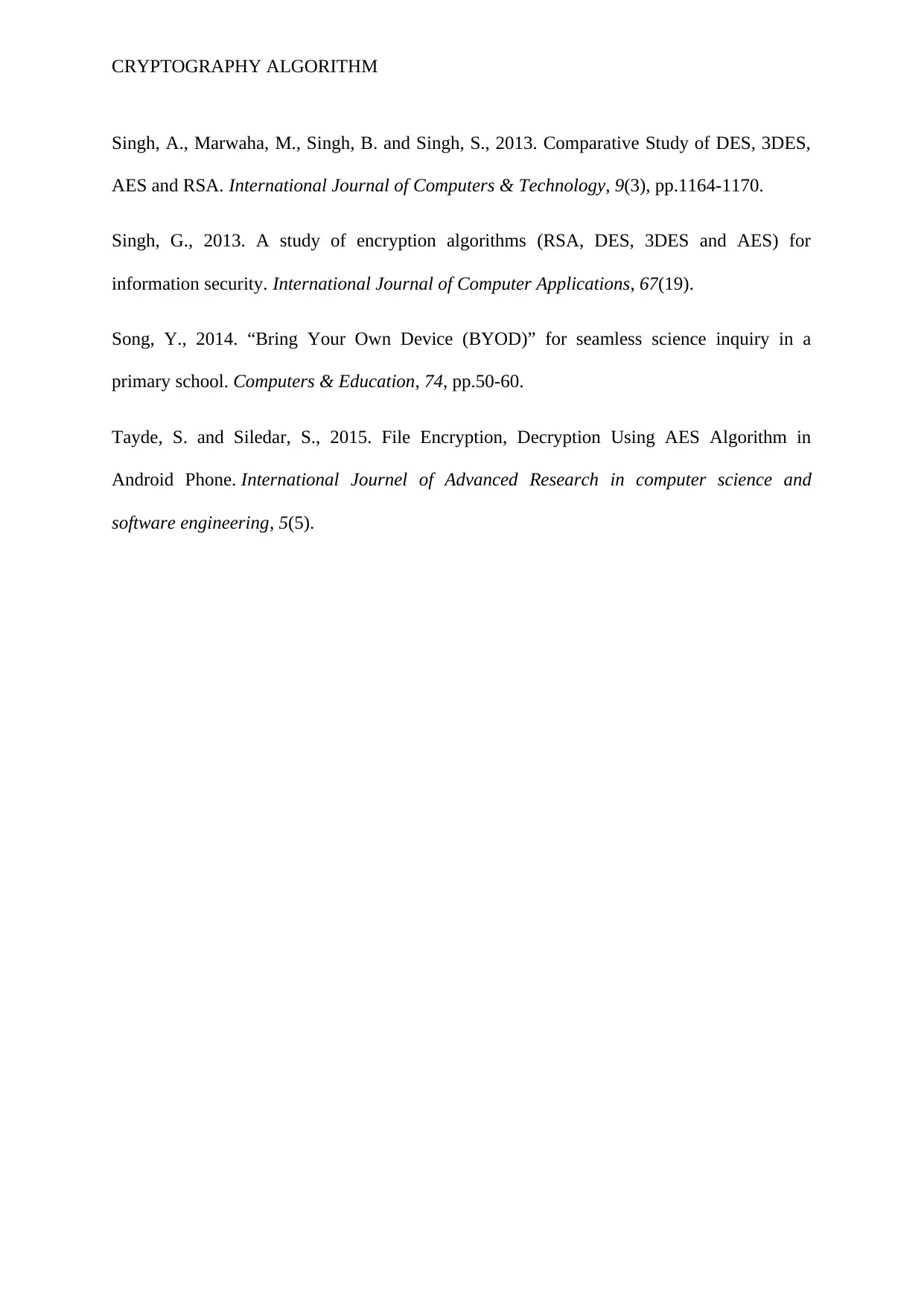
CRYPTOGRAPHY ALGORITHM
Singh, A., Marwaha, M., Singh, B. and Singh, S., 2013. Comparative Study of DES, 3DES,
AES and RSA. International Journal of Computers & Technology, 9(3), pp.1164-1170.
Singh, G., 2013. A study of encryption algorithms (RSA, DES, 3DES and AES) for
information security. International Journal of Computer Applications, 67(19).
Song, Y., 2014. “Bring Your Own Device (BYOD)” for seamless science inquiry in a
primary school. Computers & Education, 74, pp.50-60.
Tayde, S. and Siledar, S., 2015. File Encryption, Decryption Using AES Algorithm in
Android Phone. International Journel of Advanced Research in computer science and
software engineering, 5(5).
Singh, A., Marwaha, M., Singh, B. and Singh, S., 2013. Comparative Study of DES, 3DES,
AES and RSA. International Journal of Computers & Technology, 9(3), pp.1164-1170.
Singh, G., 2013. A study of encryption algorithms (RSA, DES, 3DES and AES) for
information security. International Journal of Computer Applications, 67(19).
Song, Y., 2014. “Bring Your Own Device (BYOD)” for seamless science inquiry in a
primary school. Computers & Education, 74, pp.50-60.
Tayde, S. and Siledar, S., 2015. File Encryption, Decryption Using AES Algorithm in
Android Phone. International Journel of Advanced Research in computer science and
software engineering, 5(5).
1 out of 11
Related Documents
Your All-in-One AI-Powered Toolkit for Academic Success.
+13062052269
info@desklib.com
Available 24*7 on WhatsApp / Email
![[object Object]](/_next/static/media/star-bottom.7253800d.svg)
Unlock your academic potential
Copyright © 2020–2025 A2Z Services. All Rights Reserved. Developed and managed by ZUCOL.




